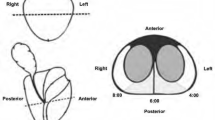Summary
A stereological model which provides information on the structure of the normal dog prostate has been developed. The model consists of the morphologically defined space and membrane components which are used to describe the specific components of the protein and enzyme synthesising glandular cells. Comparisons of the dog, rat and normal human prostate in regard to quantitative light and electron microscopic analysis are presented.
Similar content being viewed by others
Abbreviations
- P:
-
Prostate
- IT:
-
Interacinar (=stromal) tissue
- AP:
-
Acinar parenchyma
- AL:
-
Acinar lumina
- AC:
-
Acinar glandular cell
- N:
-
Nucleus
- CYT:
-
Cytoplasm
- GS:
-
Ground substance
- MI:
-
Mitochondria
- RER:
-
Roughendoplasmic reticulum
- GA:
-
Golgi apparatus
- SG:
-
Secretory granules
- F:
-
Fat droplets
- VV :
-
Volume density
- PT :
-
Total number of points of the test system
- P:
-
Number of counted points
- m:
-
Mean
- s.e.:
-
Standard error
References
Bartsch, G., Fischer, E., Rohr, H. P.: Ultrastructural morphometric analysis of the rat prostate (ventral lobe). Urological Research 3, 1 (1975)
Bartsch, G., Müller, H. R., Oberholzer, M., Rohr, H. P.: Light microscopic stereological analysis of the normal human prostate and of human benign prostatic hyperplasia. Journal of Urology (in press)
Gloyna, R. E., Wilson, J. D.: A comparative study of the conversion of testosterone to 17-β-hydroxy-5α-androstan-3α by prostate and epididymis. Journal of Clinical Endocrinology and Metabolism 29, 970 (1969)
Gloyna, R. E., Siiteri, P. K., Wilson, J. D.: Dihydrotestosterone in prostatic hypertrophy. II. The formation and content of dihydrotestosterone in the hypertrophic canine prostate and the effect of dihydrotestosterone on prostate growth in the dog. Journal of Clinical Investigation 49, 1746 (1970)
Huggins, C.: The physiology of the prostate gland. Physiological Reviews 25, 281 (1945)
HugginsC.: The etiology of benign prostatic hypertrophy. Bulletin of the New York Academy of Medicine 23, 696 (1947)
Moore, R. A.: Benign hypertrophy and carcinoma of the prostate. Occurrence and experimental production in animals. Surgery (St. Louis) 16, 152 (1944)
Rohr, H. P., Oberholzer, M., Bartsch, G., Keller, M.: Morphometry in experimental pathology (methods, baseline data and applications). International Review of Experimental Pathology
Siiteri, P. K., Wilson, J. D.: Dihydrotestosterone in prostatic hypertrophy. I. The formation and content of dihydrotestosterone in the hypertrophic prostate of man. Journal of Clinical Investigation 49, 1737 (1970)
Walsh, P. C.: Experimental approaches to benign prostatic hypertrophy: Animal models utilizing the dog, rat and mouse. Benign prostatic hyperplasia, NIAMDD Workshop Proceedings, 215 (1975)
Weibel, E. R.: Stereological principles for morphometry in electron microscopic cytology 26, 235 (1969)
Author information
Authors and Affiliations
Additional information
Supported by the Swiss National Science Foundation (3. 722. 76) Switzerland and by the Fonds zur Förderung der-wissenschaftlichen Forschung (3278), Austria
Rights and permissions
About this article
Cite this article
Rohr, H.P., Krisl, I., Holliger, O. et al. Stereological analysis of the dog prostate (analytical model). Urol. Res. 9, 193–199 (1981). https://doi.org/10.1007/BF00264826
Accepted:
Issue Date:
DOI: https://doi.org/10.1007/BF00264826




